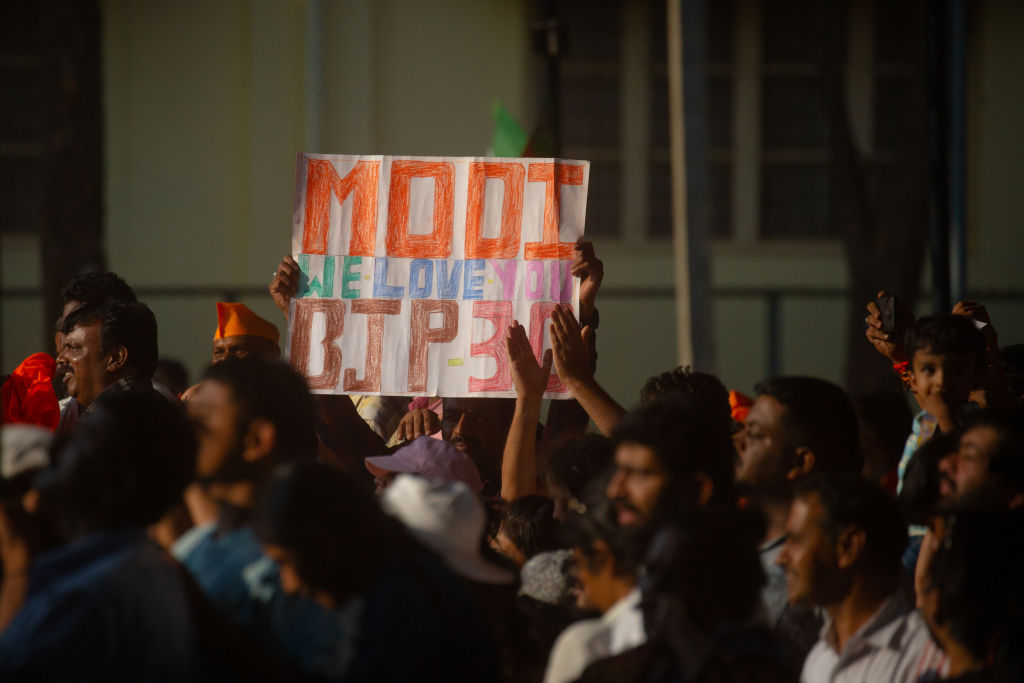
Earlier this month, two Indian writers published an ode to their Prime Minister, Narendra Modi. Written in lyric form and titled “Forever In Our Hearts,” it recounts his achievements while singing his praises in highly effusive language. “With courage and wisdom/you show citizens the way,” it gushes. “Oh Modi, oh Modi/their hopes never sway/A people’s beacon, in whom they see light/Oh Modi, oh Modi, guiding day and night.”
Such reverence captures the essence of Modi’s popularity. Many simply respect him; many others seemingly worship him. He’s beloved by a large majority of the country, as evidenced by an approval rating that climbed to a new high of 75% earlier this year. Victory in the upcoming general elections—which begins Friday and runs through June 1—is widely expected.
There’s much that explains Modi’s popularity. That includes his personality (supporters view him as incorruptible), leadership and communication styles, and his policy achievements at home and abroad—not to mention a weak opposition and the massive BJP machine behind him. Above all, and perhaps most worryingly, he’s won over millions for his government’s aggressive Hindu nationalism. That includes laws and policies that discriminate against Muslims (such as denying fast-track citizenship to Muslim refugees from neighboring nations, restricting or banning beef in some states, and expunging mentions of Muslim history from school textbooks). Some of Modi’s party colleagues and supporters have resorted to hate speech, and the country has seen pronounced and rising numbers of attacks on religious minorities. Modi supporters have also propagated conspiracy theories against Muslims (including the “love jihad” that baselessly claims that Muslim men court Hindu women to force them to convert). This has all played out against shrinking space for dissent, with crackdowns on media and broader civil society.
Not all of this is unprecedented. Pre-Modi, India experienced religious tensions (and deadly riots). Indian Muslims have tended to be the most vulnerable, but communal tensions have harmed Christians and Sikhs. There have also been periods where democracy struggled—including states of emergency between 1975 and 1977. It was justified by the then-government of Indira Gandhi (of the Congress party) to restore law and order following massive opposition protests. But those cases were episodic. What’s happening today is continuous, and playing out on a greater scale. And much of it—including the Prime Minister publicly performing religious ceremonies—is very new.
Read More: India’s Ayodhya Temple Is a Huge Monument to Hindu Supremacy
The Modi-era actions are highly controversial because of India’s constitutionally enshrined secular traditions and resilient democracy. But while this Modi-fication of India has not gone down well with many citizens—particularly Muslims—it has far too many backers to be characterized as a wholesale trampling on the public will. This may be the tyranny of the majority, but it’s also something that enjoys a public mandate.
For Modi and his mammoth base, this new India is stronger domestically and internationally, more confident, and utterly democratic. It delivers big-bang achievements—from landing on the moon to becoming a top-performing economy. The Modi-ification of India has provoked pushback, and even mass protests. But rarely has Modi reversed course on a new policy or law—and never on religion-based issues. The same is likely to be true in a third Modi term.
On the international stage, Modi’s policies have generated extensive criticism. Yet foreign governments are in no position to do anything about it. The West perceives India—because of its size, military, and economic clout—as a crucial partner in efforts to counter China. Much of the broader world sees India as a partner in these or other ways. There is little appetite to upset India over internal affairs or use any leverage to push a change of tack. It’s India, therefore, not its critics, that has leverage to wield.
There is little choice, then, but to accept the reality of a Modi-fied India, and that India will be what Modi and so many of his compatriots want it to be.
For the West, this is easy when guided by purely strategic concerns. Sure, there are positions India takes—like its embrace of multipolarity, which risks diluting U.S. power, and its enduring partnership with Russia—that don’t thrill Western capitals. Yet the Modi-fication of India could undermine the U.S. and its allies’ interests. For instance, Washington wants India to attract more foreign tech firms to reduce their presence in China. But New Delhi’s crackdown on social media content risks scaring some away. A third Modi term could also produce more communal unrest, distracting his government’s foreign policy bandwidth.
All that said, the Modi-fication of India is not necessarily irreversible. Whether after his third term or beyond, the 73-year-old Modi will have to retire. The BJP, deprived of its wildly popular leader, may struggle to adjust without a man so closely associated with the party. This may provide an opening for a Congress that has floundered since losing power in 2014.
Political opportunities could also emerge for new BJP leaders with different ideas and policies. Much will depend on who succeeds Modi as BJP head. The two top candidates, interior minister Amit Shah and Uttar Pradesh chief minister Yogi Adityanath, are fervent and at times aggressive proponents of Hindu nationalism. Other possible successors are more moderate.
Nevertheless, for now and certainly in the immediate aftermath of June 1, don’t expect any modifications to India’s Modi-fication.
More Must-Reads From TIME
- The 100 Most Influential People of 2024
- How Far Trump Would Go
- Scenes From Pro-Palestinian Encampments Across U.S. Universities
- Saving Seconds Is Better Than Hours
- Why Your Breakfast Should Start with a Vegetable
- 6 Compliments That Land Every Time
- Welcome to the Golden Age of Ryan Gosling
- Want Weekly Recs on What to Watch, Read, and More? Sign Up for Worth Your Time
Write to Michael Kugelman at michael.kugelman@wilsoncenter.org